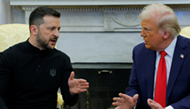he Fed’s Pivot After 2.5 Years… Proactive Response Amid Recession Concerns
▶ Evaluation: ‘Sustained Robust Growth’
▶ Conscious of ‘Too Late’ Criticism in Case of Worsening Economy

Jerome Powell, Chair of the Federal Reserve, is explaining the background behind the decision to implement a substantial rate cut during a press conference held right after the Federal Open Market Committee (FOMC) meeting on the 18th. [Reuters]
The Fed raised rates sharply starting in March 2022 to counter inflation, which surged due to pandemic-related stimulus measures and supply chain disruptions. This increased the rate to its highest level in 22 years, reaching 5.25-5.50%. It maintained this rate until now. However, with the U.S. consumer price index (CPI) slowing to 2.5% in August, and major central banks like the European Central Bank (ECB) and the Bank of England (BOE) starting their rate cut cycles, the Fed hinted earlier this month at the beginning of rate cuts.
On August 23, Fed Chairman Jerome Powell declared at the Jackson Hole meeting, "The time for policy adjustments (rate cuts) has come," effectively signaling the end of the inflation fight.
There Was a Reason to Move Quickly
There was little debate that the Fed would initiate a rate cut at this meeting. However, there was considerable disagreement among experts about the size of the initial cut and the pace of future cuts. The confusion stemmed from the fact that while the U.S. economy is slowing, it hasn’t decelerated quickly enough to justify rapid rate cuts by the Fed.
On the other hand, there was also strong support for the Fed to move swiftly with rate cuts. Given the possibility of a sudden cooling in the labor market, the argument was that the Fed needed to quickly return rates to more normal levels to avoid being criticized for acting too late.
Former New York Federal Reserve President William Dudley urged the Fed to lower rates early, writing in a July op-ed that "it may already be too late to prevent a recession through rate cuts." He suggested that a large rate cut in September was inevitable. The logic was that since rates were still high, a large cut now would not cause regret. However, if only a small cut was made, and the labor market deteriorated rapidly, the Fed would be left regretting its decision.
"Uncertainty in Economic Outlook" Reflected
It is known that there was significant division within the Fed regarding the 'big cut,' but ultimately the FOMC members sided with the argument for proactive action.
This perspective is reflected in the FOMC statement. The Fed acknowledged that “recent data shows that economic activity in the U.S. continues to expand at a robust pace," and while “the unemployment rate has risen, it remains at a low level.” In this way, the Fed recognized that the U.S. economy is not in bad shape. However, the Fed also emphasized that “the economic outlook is uncertain, and the FOMC is attentive to risks on both sides of its dual mandate.” This suggests that concerns about the rapid cooling of the labor market were a key factor in the decision for a big cut.
Outlook
With the Fed's pivot, the tightening policies of major countries are effectively coming to an end. Switzerland was the first developed country to open the door to rate cuts in March, followed by the ECB and Canada in June, both making their first rate cuts in several years. In August, the BOE also shifted its monetary policy for the first time in four years since the pandemic. It is widely expected that the Fed’s rate cut movement, which began this month, will continue for some time. Large investment banks such as Goldman Sachs, Bank of America (BofA), and Barclays predict that the Fed will make additional rate cuts in November and December, bringing the U.S. benchmark rate to around 4.75% (upper limit) by the end of the year. JPMorgan and Citi are even forecasting rates as low as 4.25%.
The Fed's rate cuts are expected to immediately become a significant factor in the monetary policy decisions of other major countries. The BOE and Bank of Japan (BOJ) are scheduled to decide on their respective benchmark rates on the 19th and 20th. Emerging market central banks are expected to be even more influenced by these decisions.
By: Hong-Yong Park
<Hongyong Park>
스마터리빙
more [ 건강]
[ 건강]이제 혈관 건강도 챙기자!
[현대해운]우리 눈에 보이지 않기 때문에 혈관 건강을 챙기는 것은 결코 쉽지 않은데요. 여러분은 혈관 건강을 유지하기 위해 어떤 노력을 하시나요?
 [ 건강]
[ 건강]내 몸이 건강해지는 과일궁합
 [ 라이프]
[ 라이프]벌레야 물럿거라! 천연 해충제 만들기
 [ 건강]
[ 건강]혈압 낮추는데 좋은 식품
[현대해운]혈관 건강은 주로 노화가 진행되면서 지켜야 할 문제라고 인식되어 왔습니다. 최근 생활 패턴과 식생활의 변화로 혈관의 노화 진행이 빨라지고
사람·사람들
more많이 본 기사
- 마지막 토요일도 도심 집회… “내란 단죄” vs “윤 어게인”
- 쿠팡 ‘정부 반박’ 영문성명 미묘한 표현차… ‘잘못된 비난’ 부각
- “SD서 최고 활약 김하성, 2024시즌만큼만 쳐줘도 ATL 3승 더한다” ESPN 극찬
- 뉴욕시 폭설에 항공기 수천편 취소·지연 사태
- 보수 야당 “의원직 사퇴하고 법심판 받아야”…김병기에 총공세
- 특검, ‘로저비비에’ 김기현 부부 기소…尹 뇌물 수사는 경찰로
- 황하나, 남편 사망→캄보디아서 남친과 출산..귀국 후 구속 ‘파란만장’
- 국힘 “신천지로 통일교 특검 물타기 안돼”…與 “성역없이 규명”
- IS 확실했나…트럼프 ‘성탄절 나이지리아 폭격’ 갸우뚱
- “솔직히 자신은 없죠” 3루수 GG 송성문, 유격수도 아닌 외야라니... 생존 본능 발동할까
- 황하나, 마약 도피 중 캄보디아서 출… 1
- 올해 美 기업 파산신청 증가… “관세·고물가·고금리 원인”
- 오윤아 “子, 학교 떨어져 잘못 키웠나..방치 했나 싶어 눈물”
- “2025년 높이뛰기는 우상혁과 커의 무대” 세계육상연맹 조명... 우상혁도 “커와 계속 경쟁해야 해”
- 러, 젤렌스키 미국행 앞 대규모 공습…우크라도 러에 드론 공격
- “아동 수출국 오명 벗는다” 70년 만에 해외입양 중단
- “올해 최고 주목받은 테크 거물은 머스크 아닌 래리 엘리슨”
- “올해 최고 주목받은 테크 거물은 머스크 아닌 래리 엘리슨”
- 트럼프 “소말릴란드 아는 사람 있나?”…이스라엘 승인에 ‘NO’
- 韓정부, 노란봉투법 해석 지침 공개… 하청 임금·근로조건 좌우하면 ‘진짜 사장’
- 이혁재가 또.. “빌려간 3억원 안 갚아” 사기 혐의로 피소
- ‘서해 공무원 피격 은폐’ 혐의 서훈… 2
- ‘김건희에 로저비비에 선물’ 김기현 부인 특검 재출석…곧 기소
- ‘손흥민 감격의 첫 우승’ 올해 축구계 기적 톱8 선정 ‘선수로는 유일’
- ‘NCT 탈퇴’ 태일, 성폭행 혐의로 결국 감옥行..징역 3년 6개월 확정
- 곽도원, 음주운전 3년 만 복귀각..스토리제이컴퍼니 측 “미팅 했지만 계약 단계 아냐”
- 8시즌 뛰고 ML 역대 17위 “오타니 GOAT 될 것”, ML 역대 50인 선정
- [이지 사이언스] “온난화 막으려면 세계인구 44% 식단 바꿔야…문제는 소고기”
- 효연, 소녀시대 수입 서열 공개 “1위 나 아냐..윤아·태연이 더 벌어”
- 국제은값 폭등에 개인투자자들 銀투자 대거 유입
- 러, 트럼프-젤렌스키 종전회담 직전 … 1
- 한파에 고드름이 주렁주렁… 서울 이번 겨울 첫 한파주의보
- 찰스 3세, 내년 방미 추진…트럼프에 英왕실 ‘매력 공세’될까
- LA 등 서부에 사흘째 폭우…동부엔 폭설 예보
- “도시 빈민에 전한 성탄의 온기”
- 쏟아지는 갑질·특혜 의혹… 버티는 김병기, 속 끓는 정청래
- 물류거점창고에 불체자 8만명 수용 추진
- ‘마약 혐의’ 남양유업 3세 황하나 구속… “증거인멸 우려”
- 한미장학재단에 3만달러 영구장학금 기탁
- 복음으로 세상 섬길 인재 배출
- ‘역대 최연소’ 백악관 대변인 레빗,… 1
- 소싯적 ‘치기어린’ 주소 “굿바이”…지메일 주소변경기능 도입
- 16세로 성장한 버클리 문학, 성대한 송년 파티
- “온 세상에 희망·평화의 빛 스며들길”
- 특검, 김건희 ‘금품 수수’ 무더기 기소… 뇌물 여부는 경찰 몫으로
- “출생시민권은 사기”⋯ 이민 2세대 공격 초점 맞춘 트럼프
- ‘정보 유출자 셀프 조사’ 경찰에 늦게 알린 쿠팡… 증거인멸 의혹
- 작년 운용자산 5조5천억달러…갑부들의 ‘패밀리오피스’ 월가 새 강자로
- 쿠팡, 자체 조사결과 발표후 첫거래일 급등…뉴욕증시서 6%↑
- [새해부터 이렇게 달라진다] 최저임금 또 오르고… 유급 병가는 더 확대
1/5지식톡

-
 미 육군 사관학교 West Poin…
0
미 육군 사관학교 West Poin…
0https://youtu.be/SxD8cEhNV6Q연락처:wpkapca@gmail.comJohn Choi: 714-716-6414West Point 합격증을 받으셨나요?미 육군사관학교 West Point 학부모 모…
-
 ☝️해외에서도 가능한 한국어 선생님…
0
☝️해외에서도 가능한 한국어 선생님…
0이 영상 하나면 충분합니다!♥️상담신청문의♥️☝️ 문의 폭주로 '선착순 상담'만 진행합니다.☎️ : 02-6213-9094✨카카오톡ID : @GOODEDU77 (@골뱅이 꼭 붙여주셔야합니다…
-
 테슬라 자동차 시트커버 장착
0
테슬라 자동차 시트커버 장착
0테슬라 시트커버, 사놓고 아직 못 씌우셨죠?장착이 생각보다 쉽지 않습니다.20년 경력 전문가에게 맡기세요 — 깔끔하고 딱 맞게 장착해드립니다!장착비용:앞좌석: $40뒷좌석: $60앞·뒷좌석 …
-
 식당용 부탄가스
0
식당용 부탄가스
0식당용 부탄가스 홀세일 합니다 로스앤젤레스 다운타운 픽업 가능 안녕 하세요?강아지 & 고양이 모든 애완동물 / 반려동물 식품 & 모든 애완동물/반려동물 관련 제품들 전문적으로 홀세일/취급하는 회사 입니다 100% …
-
 ACSL 국제 컴퓨터 과학 대회, …
0
ACSL 국제 컴퓨터 과학 대회, …
0웹사이트 : www.eduspot.co.kr 카카오톡 상담하기 : https://pf.kakao.com/_BEQWxb블로그 : https://blog.naver.com/eduspotmain안녕하세요, 에듀스팟입니다…
케이타운 1번가
오피니언

새해 더 중요해지는 노동법 준수

연말연시, 안전하고 차분하게
 캐슬린 파커 워싱턴포스트 칼럼니스트
캐슬린 파커 워싱턴포스트 칼럼니스트 [캐슬린 파커 칼럼] 지미 라이의 마지막 희망
 유경재 나성북부교회 담임목사
유경재 나성북부교회 담임목사 [한국춘추] 미국의 힘
 전병두 서북미수필가협회 회원
전병두 서북미수필가협회 회원 [금요단상] 비자 발급
 박일근 / 한국일보 수석논설위원
박일근 / 한국일보 수석논설위원 [지평선] 스님의 주례사
 신상철 / 고려대 고고미술사학과 교수
신상철 / 고려대 고고미술사학과 교수 [미술 다시보기] 신의 모습을 닮고자 한 예술가
 스티브 강 전 한인민주당협회 회장
스티브 강 전 한인민주당협회 회장 [스티브 강 ‘인사이드 미국’] 2026 중간선거: 트럼프 지지율 하락이 말해주는 것
 김홍일 케이유니콘인베스트먼트 대표
김홍일 케이유니콘인베스트먼트 대표 [기고] 안정의 기준은 어떻게 제도가 되었나
1/3지사별 뉴스

물류거점창고에 불체자 8만명 수용 추진
도널드 트럼프 행정부가 이민자 구금·추방을 효율화하기 위해 전국 물류거점 창고에 8만명 규모의 수용시설 확보를 추진한다고 24일 워싱턴 포스트…
‘학자금 상환’ 안하면 임금압류

“온 세상에 희망·평화의 빛 스며들길”
가자지구와 우크라이나에서의 전쟁, 고립과 불평등으로 세상이 어지러운 가운데 워싱턴 지역 각급 한인교회와 성당들이 성탄절을 맞아 일제히 예배와 …
“연말은 스트레스·새해 결심은 없다”

“올해 최고 주목받은 테크 거물은 머스크 아닌 래리 엘리슨”
올해 미국에서 가장 주목받은 기술업계 거물은 일론 머스크 테슬라 최고경영자(CEO)가 아닌 래리 엘리슨 오라클 창업자·회장이라고 블룸버그 통신…
[새해부터 이렇게 달라진다] 최저임금 또 오르고… 유급 병가는 더 확대

오늘 하루 이 창 열지 않음 닫기 



















































.png)


댓글 안에 당신의 성숙함도 담아 주세요.
'오늘의 한마디'는 기사에 대하여 자신의 생각을 말하고 남의 생각을 들으며 서로 다양한 의견을 나누는 공간입니다. 그러나 간혹 불건전한 내용을 올리시는 분들이 계셔서 건전한 인터넷문화 정착을 위해 아래와 같은 운영원칙을 적용합니다.
자체 모니터링을 통해 아래에 해당하는 내용이 포함된 댓글이 발견되면 예고없이 삭제 조치를 하겠습니다.
불건전한 댓글을 올리거나, 이름에 비속어 및 상대방의 불쾌감을 주는 단어를 사용, 유명인 또는 특정 일반인을 사칭하는 경우 이용에 대한 차단 제재를 받을 수 있습니다. 차단될 경우, 일주일간 댓글을 달수 없게 됩니다.
명예훼손, 개인정보 유출, 욕설 등 법률에 위반되는 댓글은 관계 법령에 의거 민형사상 처벌을 받을 수 있으니 이용에 주의를 부탁드립니다.
Close
x